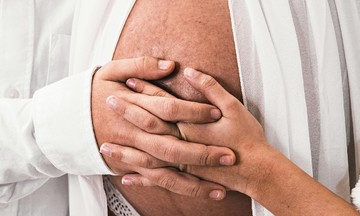"The journey to motherhood at an older age is not easy," Hoai shared.
After a natural pregnancy ended in miscarriage at 14 weeks, Hoai underwent surgery to remove a deeply embedded placenta and separate uterine adhesions. She and her husband then tried intrauterine insemination (IUI) three times, but without success. Turning to in-vitro fertilization (IVF), they faced further disappointment as most of the created embryos stopped developing early on. Only two day-3 embryos remained, but neither resulted in a pregnancy.
Last year, they sought help from the Fertility Support Center at Tam Anh General Hospital in Ho Chi Minh City (IVF Tam Anh TP HCM). At 41, Hoai’s ovarian reserve was almost depleted, with an anti-Müllerian hormone (AMH) level of just 0.7 ng/mL and only a few follicles (eggs) visible on ultrasound.
Dr. Giang Huynh Nhu, Director of the Center, explained that Hoai’s history of early embryo arrest suggested potential egg quality issues. "But as long as there are eggs, there is hope for having your own child," Dr. Nhu reassured.
 |
Dr. Nhu shares positive embryo news with the couple. Illustrative photo: Thanh Luan |
Dr. Nhu designed a tailored ovarian stimulation protocol for Hoai, aiming to mature the few remaining eggs. Hoai took medication for 8-10 days, with regular ultrasounds to monitor follicle development. The procedure yielded seven mature eggs.
Embryologists selected suitable sperm and injected them into each egg's cytoplasm to enhance fertilization. The embryos were cultured in a dynamic incubator within a meticulously clean "lab-within-a-lab" environment, providing optimal pH, gas levels, and humidity. Constant camera monitoring allowed embryologists to observe their development, resulting in three day-5 embryos.
All embryos underwent preimplantation genetic testing (PGT) to minimize the risk of chromosomal abnormalities that could reduce IVF success rates, increase the risk of birth defects, and lead to pregnancy complications like miscarriage and premature birth. Embryologists biopsied 6-10 cells from the trophectoderm (the part that develops into the placenta) of each embryo, identifying a single embryo free of genetic abnormalities.
 |
A healthy, genetically normal day-5 embryo cultured at IVF Tam Anh. Photo: Thu Thao |
Had this transfer failed, Hoai and her husband would have had to restart the entire IVF process, facing higher costs, emotional and physical strain, and lower chances of success. Dr. Nhu meticulously prepared Hoai's uterine lining, performing a hysteroscopy to check for recurring adhesions. Once the lining was optimal, the single embryo was transferred, successfully implanting and leading to pregnancy. Last month, Hoai gave birth to a healthy baby boy weighing over 3 kg.
According to Dr. Nhu, age is a crucial factor in female reproductive health. Egg count starts declining after 30, accelerating between 35 and 40, until complete depletion at menopause. Hormonal changes make remaining eggs more prone to chromosomal abnormalities and errors during cell division, increasing the risk of birth defects like Down syndrome and Edwards syndrome, as well as pregnancy complications such as miscarriage and premature birth.
Dr. Nhu advises women to marry and complete their families before 35. Those delaying childbirth should consider egg freezing to preserve fertility and control the timing of healthy pregnancies. Older women undergoing IVF are encouraged to opt for preimplantation genetic testing to minimize the risk of birth defects and ensure the birth of healthy children.
Hoai Thuong
*The patient's name has been changed












